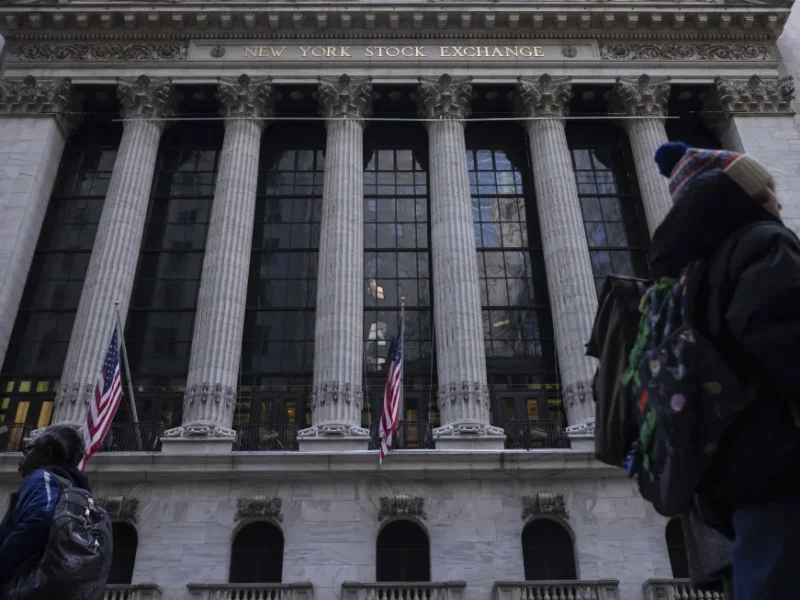The first quarter of 2024 saw remarkable market performance, despite grappling with sustained higher interest rates on Wall Street.
Investors closed out 2023 with high optimism, navigating through a regional banking crisis and geopolitical tensions to usher in a robust bull market. The economy defied expectations of a recession, and anticipation grew for the Federal Reserve’s anticipated series of rate cuts, initially expected to start in March.
However, a series of strong economic indicators and cautionary statements from Fed officials prompted investors to adjust their expectations, aligning with the Fed’s projected three rate cuts, likely commencing in June or July.
Despite intermittent market downturns, the stock market continued its upward trajectory fueled by strong corporate earnings and a resilient labor market, instilling confidence in the economy’s ability to evade recession. The S&P 500 surged by 10.2% in the first quarter, marking its best performance for that period since 2019. Meanwhile, the Dow Jones Industrial Average and the Nasdaq Composite gained 5.6% and 9.1%, respectively.
The S&P 500 logged its 22nd record-high close of the year, with the first 17 recorded within the first 50 trading days of 2024—the highest count during this period since 1998, as reported by Bespoke Investment Research. Both the Dow and Nasdaq also achieved multiple record highs.
While some major tech stocks, like Apple and Tesla, experienced setbacks due to concerns over sales and performance, others like Nvidia, Meta, Microsoft, and Amazon saw substantial double-digit gains.
Beyond tech, broader market indicators also showed strength. The S&P 600 index, tracking US small caps, hit a 52-week high, and gold prices surged to multiple all-time highs. Bitcoin also reached fresh highs after US regulators approved spot exchange-traded funds linked to the cryptocurrency.
Looking ahead, Leslie Thompson, Chief Investment Officer at Spectrum Wealth Management, predicts continued market expansion driven by robust corporate earnings. Analysts anticipate S&P 500 earnings to grow by over 10% throughout 2024.
Historically, new highs early in the year often signal positive annual returns, according to CFRA Research data. However, some indicators, including Warren Buffett’s preferred metrics, suggest overvaluation relative to economic performance. Investors remain cautious, particularly regarding persistent inflation, which could disrupt the Fed’s plans.
Despite vigilance for potential risks, such as inflation, Zachary Hill, Head of Portfolio Management at Horizon Investments, sees limited major risks on the horizon.
Disney and Governor DeSantis have resolved their disagreement.
Disney and Florida have been engaged in a prolonged conflict, but it appears that the dispute is coming to a close as they have reached a settlement, as reported by Elisabeth Buchwald and Samantha Delouya.
During a meeting on Wednesday morning, the Central Florida Tourism Oversight District board, responsible for governing the special tax district where Disney operates, approved the settlement to resolve the legal disagreement.
Governor Ron DeSantis, a Republican, established the Central Florida Tourism District nearly two years ago to supervise the area where Disney is situated, amidst escalating tensions between the Florida governor and the entertainment conglomerate.
The dispute between Disney and DeSantis erupted in March 2022 when then-CEO Bob Chapek criticized a contentious bill known as “Don’t Say Gay,” which restricts certain forms of instruction regarding sexual orientation and gender identity in classrooms. Chapek denounced the bill as a threat to fundamental human rights.
Following Chapek’s remarks, DeSantis urged the Florida legislature to revoke Disney’s longstanding special privileges in Central Florida and appointed a new board of supervisors to oversee the district.
The board had threatened to increase taxes, raise utility rates, and develop the land surrounding Disney’s Central Florida theme parks. Last year, Disney filed a lawsuit against DeSantis and his allies, alleging infringement of the company’s freedom of speech.
Governor DeSantis expressed satisfaction with the settlement during a press conference in Orlando on Wednesday, stating, “Everything we’ve done has been in the best interests of the state of Florida. I’m glad that they were able to do that settlement.”
“Baltimore can draw valuable lessons from Minneapolis’ recovery following the I-35W bridge collapse 17 years ago.”
The recent collapse of the Francis Scott Key Bridge in Baltimore echoes previous tragedies in the US, including the catastrophic failure of the Interstate 35W bridge in Minneapolis 17 years ago, as reported by my colleague Alicia Wallace.
The response to the Minneapolis bridge collapse, considered one of the most significant in recent history, offers valuable insights for Baltimore’s recovery efforts.
On August 1, 2007, during the congested evening rush hour on Interstate 35W, the eight-lane bridge spanning the Mississippi River suddenly gave way, plunging into the river and railyard below. Thirteen fatalities and nearly 150 injuries resulted from the collapse.
Beyond the loss of life and immediate damage, the collapse severed a vital transportation link for the Twin Cities, with approximately 140,000 vehicles traversing the bridge daily, situated over 100 feet above the Mississippi.
Initial estimates projected a substantial economic impact, with the state of Minnesota anticipating a daily loss of $113,000 in economic output (equivalent to approximately $17 million in 2007 and $43 million in 2008). Concerns mounted over potential traffic disruptions statewide.
Surprisingly, the expected severe traffic congestion did not materialize, and remarkably, a new bridge was constructed in just 13 months.
Christopher Phelan, an economics professor at the University of Minnesota, noted, “The economic impact was orders of magnitude less than people had feared,” attributing this outcome to the population’s rapid adaptability to the situation.










